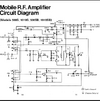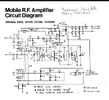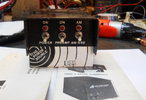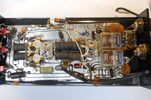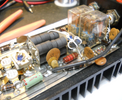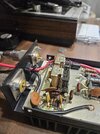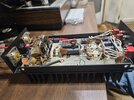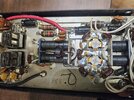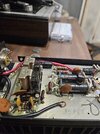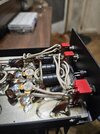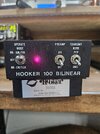You are using an out of date browser. It may not display this or other websites correctly.
You should upgrade or use an alternative browser.
You should upgrade or use an alternative browser.
-
You can now help support WorldwideDX when you shop on Amazon at no additional cost to you! Simply follow this Shop on Amazon link first and a portion of any purchase is sent to WorldwideDX to help with site costs.
Losing receive with amp connected
- Thread starter ShadowDelaware
- Start date
Shadetree Mechanic
Delaware Base Station 808
Check the keying relay, if the amplifier is keyed on receive it will do this. Instability in the amplifier output can cause oscillations that will keep it keyed.
The amplifier is about 40 years old, probably more. This is what we call the "barrel connector test".
Any time we hook up an amplifier to check, we put a SWR meter in line between the amp and the radio. Before connecting power to the amplifier, we key the radio and see that all the radio's wattage passes safely though the amplifier.
As if it were a barrel connector. If it flunks this test, there is no good reason to connect power to it.
You didn't say if it does this with the power off? Or does it do this only when the amplifier is powered up?
Makes a difference.
73
Any time we hook up an amplifier to check, we put a SWR meter in line between the amp and the radio. Before connecting power to the amplifier, we key the radio and see that all the radio's wattage passes safely though the amplifier.
As if it were a barrel connector. If it flunks this test, there is no good reason to connect power to it.
You didn't say if it does this with the power off? Or does it do this only when the amplifier is powered up?
Makes a difference.
73
With the power off I have no output at all.The amplifier is about 40 years old, probably more. This is what we call the "barrel connector test".
Any time we hook up an amplifier to check, we put a SWR meter in line between the amp and the radio. Before connecting power to the amplifier, we key the radio and see that all the radio's wattage passes safely though the amplifier.
As if it were a barrel connector. If it flunks this test, there is no good reason to connect power to it.
You didn't say if it does this with the power off? Or does it do this only when the amplifier is powered up?
Makes a difference.
73
So you own and know how to use a volt meter?
There should be unbroken continuity from the "radio" connection to the "antenna" connection on the back when the amp is off.
That is a place to start.
Post some pictures of the inside.
73
Jeff
There should be unbroken continuity from the "radio" connection to the "antenna" connection on the back when the amp is off.
That is a place to start.
Post some pictures of the inside.
73
Jeff
That test might or might not be helpful. Some amplifiers insert a disc capacitor in the center pin of one or both coax connectors.
I'm pretty sure this amplifier has a receiver preamp. More often than not, loss of the amplifier's standby side happens inside the preamp relay. I looked in our archive, and can't find a picture of that amplifier's insides, so I don't know what kind of relay it uses. If the relay has a plastic cover that can be removed, cleaning the contacts might help. Somebody will most likely have to remove the circuit board from the chassis and identify the failed relay.
Just have a quick look at the two coax connectors. If the wire from the center pin to the circuit board has come loose, this will be a simple fix.
73
I'm pretty sure this amplifier has a receiver preamp. More often than not, loss of the amplifier's standby side happens inside the preamp relay. I looked in our archive, and can't find a picture of that amplifier's insides, so I don't know what kind of relay it uses. If the relay has a plastic cover that can be removed, cleaning the contacts might help. Somebody will most likely have to remove the circuit board from the chassis and identify the failed relay.
Just have a quick look at the two coax connectors. If the wire from the center pin to the circuit board has come loose, this will be a simple fix.
73
I'm pretty sure it is the same as digital sport systems, bimbo, bishop, squire and many more. The relays are notorious for issues.That test might or might not be helpful. Some amplifiers insert a disc capacitor in the center pin of one or both coax connectors.
I'm pretty sure this amplifier has a receiver preamp. More often than not, loss of the amplifier's standby side happens inside the preamp relay. I looked in our archive, and can't find a picture of that amplifier's insides, so I don't know what kind of relay it uses. If the relay has a plastic cover that can be removed, cleaning the contacts might help. Somebody will most likely have to remove the circuit board from the chassis and identify the failed relay.
Just have a quick look at the two coax connectors. If the wire from the center pin to the circuit board has come loose, this will be a simple fix.
73
I cleaned the contacts and my receive is back with the amp off and now the preamp just kills all receive when turned in....so I leave it off.
Should I put new contacts in it
Should I put new contacts in it
It's a great amp I can't believe it's getting 220 out of it.
Attachments
Me neither ! That amp has 2 X MRF455A power transistors in it, so max output shouldn't be more than about 120 clean watts. (Those are nominal 60 watt pills).I can't believe it's getting 220 out of it.
You are either overdriving the piss out of it, the amp is self-oscillating and spewing harmonics, or you're using a broken (or tinkered with) watt meter. Or a combination of those things.
dxChat
- No one is chatting at the moment.
-
-
dxBot:63Sprint has left the room.
-
dxBot:kennyjames 0151 has left the room.
-
-

